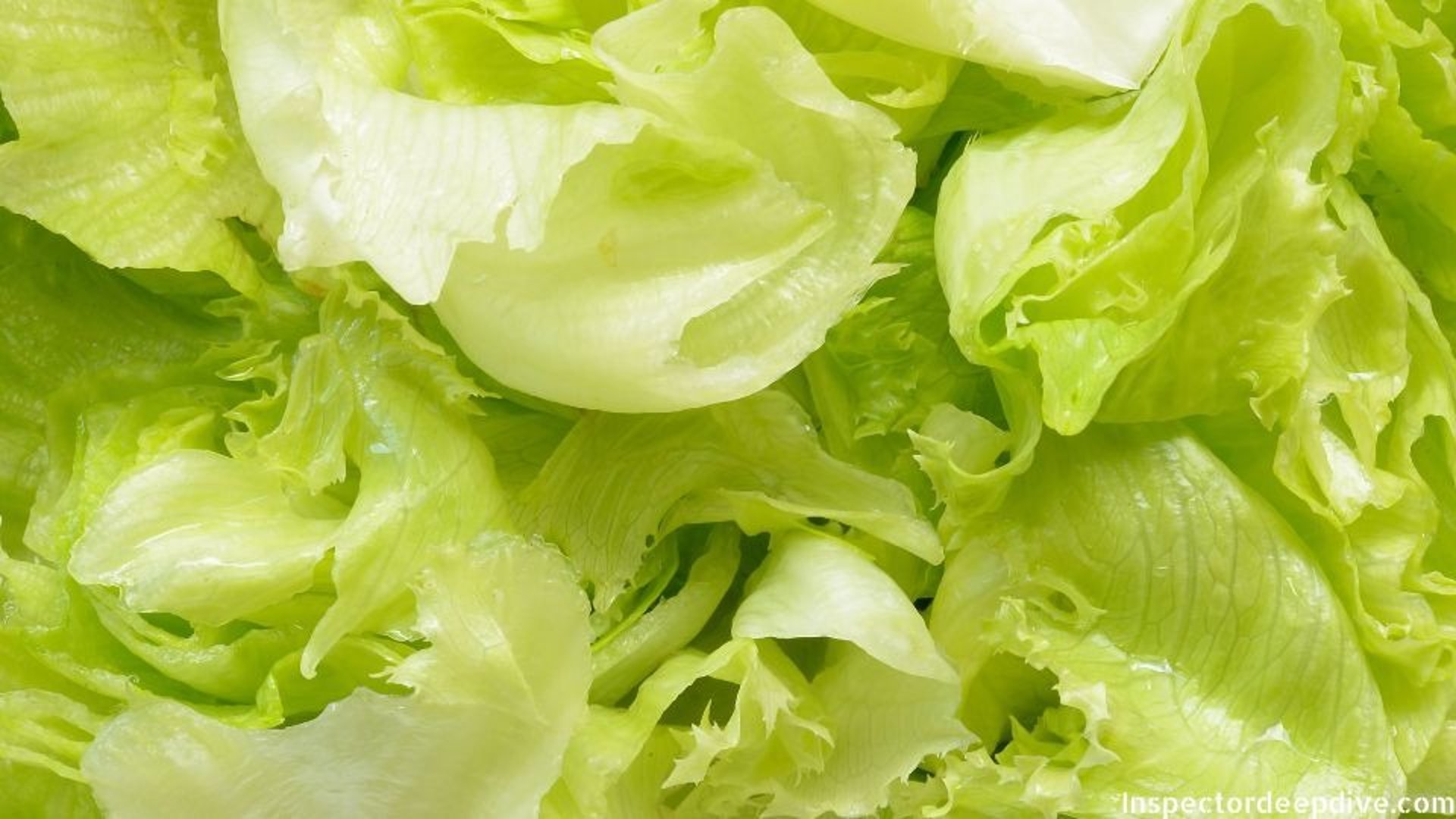
Iceberg Lettuce: Hydration and Nutrition.

Iceberg Lettuce: Hydration and Nutrition.
Scientific names: Lactuca sativa
Family: Asteraceae
What is Iceberg lettuce?
Iceberg lettuce (also called crisphead or head lettuce) is known for its tightly packed, pale‑green leaves and crunchy texture. It has a mild, neutral flavor that makes it a versatile base for salads, sandwiches, tacos and garnishes.
Where does it come from?
Iceberg lettuce traces its origins to Mediterranean wild lettuces and was developed into the modern crisphead varieties in the United States during the 20th century. It is now grown worldwide.
How many varieties?
Crisphead lettuces include several varieties such as Great Lakes, Salinas and Summertime. Iceberg is the most widely recognized type within the crisphead group.
Seasonality & availability
Iceberg lettuce is available year‑round in most regions. It grows best in cooler temperatures, so its highest quality and peak season are typically in spring and fall.
Benefits
Hydration: high water content helps maintain hydration.
Low calorie: provides bulk with very few calories, useful for weight management.
Fiber source: supplies dietary fiber to support digestion.
Vitamin K: contributes to bone health and normal blood clotting.
Nutritional breakdown (per 100 g raw, approx).
Vitamins
Vitamin K: 24 µg supports blood clotting and bone metabolism.
Vitamin A: 502 IU important for vision and immune function.
Vitamin C: 2.8 mg aids immune function and collagen production; acts as a mild antioxidant.
Folate: 38 µg supports cell division and is important in pregnancy.
Minerals
Potassium: 141 mg helps regulate fluid balance and supports heart and muscle function.
Calcium: 21 mg contributes to bone and tooth strength.
Iron: 0.5 mg needed for oxygen transport in the blood.
Magnesium: 6 mg involved in energy production and muscle/nerve function.
Macronutrients
Water: 96 g very high water content that supports hydration and adds volume to meals with few calories.
Energy: 14 kcal minimal calories, suitable for light meals and calorie‑controlled diets.
Protein: 0.9 g provides small amounts of amino acids for tissue maintenance.
Total fat: 0.2 g negligible fat, mostly unsaturated.
Carbohydrates: 2.97 g supplies gentle energy from natural sugars and fiber.
Dietary fiber: 1.2 g supports digestion and helps you feel full.
Sugars: 1.97 g naturally occurring simple sugars.
The “anti” factors
Anti‑inflammatory: contains antioxidants and vitamin K that may help modulate inflammation.
Antioxidant: includes small amounts of antioxidant compounds that protect cells from oxidative stress.
Anti‑cancer (potential): diets rich in leafy vegetables are associated with reduced risk of some chronic diseases; iceberg contributes to vegetable intake though it is lower in some phytochemicals than darker greens.
Risks and medication interactions
Pesticide residue: conventionally grown iceberg can carry pesticide residues; choose organic if this is a concern.
Medication interaction: vitamin K may affect blood‑thinning medications (e.g., warfarin). People on anticoagulants should discuss consistent vitamin K intake with their clinician.
How it affects your body
Iceberg lettuce supports hydration, supplies modest amounts of vitamins and minerals (notably vitamin K and folate), and provides fiber for digestive health all with very few calories.
Who should be cautious?
Those taking blood thinners should monitor vitamin K intake and consult their healthcare provider.
People concerned about pesticide exposure may prefer organic or thoroughly washed lettuce.
Environmental impact
Iceberg production can require substantial water and is often transported long distances, increasing its carbon footprint. Choosing locally grown and seasonally produced heads reduces environmental impact.
Best ways to use it
Iceberg is ideal for wedge salads, tacos, burgers, crunchy slaws, and as a sturdy low‑carb wrap. Its neutral flavor pairs well with creamy dressings and bold toppings.
Best time to eat
Enjoy iceberg at its best during cooler months (spring and fall) when heads are crisp and flavorful.
Storage & shelf life
Store a whole head of iceberg in the refrigerator crisper, preferably in a plastic bag or container. Kept cold and dry, it can last about a week; use outer leaves first and discard wilted or browned leaves.
Label‑reading tips
Choose heads that feel heavy for their size, are firm, and show pale‑green, unbruised leaves. Avoid heads with soft spots, browning or sliminess. Organic labels indicate reduced synthetic pesticide use.
Chef or culinary tips
Wash and dry leaves thoroughly before use. For maximum crunch, keep leaves chilled and dress just before serving. Try grilling halved heads briefly to add smoky flavor while retaining texture.
Recipes or meal ideas
Classic wedge salad with blue cheese dressing and bacon
Beef tacos with shredded iceberg for crunch
Sang choy bao / lettuce cups with stir‑fried pork or tofu
Iceberg wraps with chicken, avocado and crunchy veg
BLT sandwich with crisp iceberg leaves
2025 latest scientific information on iceberg
Recent scientific emphasis (through 2025) on leafy‑green consumption highlights two practical areas: nutrition tradeoffs and food safety. Compared with darker leafy greens, iceberg provides less of certain vitamins and phytochemicals but remains a useful source of hydration, vitamin K and dietary fiber for increasing total vegetable intake. Researchers and food‑safety agencies continue to note that leafy greens can be vehicles for foodborne pathogens if contaminated; therefore, proper farm practices, careful processing, and safe home handling (washing, refrigeration, avoiding cross‑contamination) are important for reducing risk.
If you want specific 2025 studies or extension resources about iceberg production, nutrition comparisons with other lettuces, or recent food safety guidance, I can pull and cite the latest sources for you.
Surprising truths
Iceberg is often seen as less nutritious than darker greens, yet it is one of the most hydrating salad vegetables and can encourage increased vegetable intake because many people prefer its crunch and mild taste.
It was selectively bred to be dense and crisp traits that helped its commercial success.
Frequently asked questions
Is iceberg lettuce healthy?
Yes it is hydrating, low in calories and contributes vitamins and fiber, though darker greens are richer in some nutrients.
Can you eat iceberg lettuce raw?
Yes iceberg is commonly eaten raw in salads, sandwiches and wraps.
How do you store iceberg lettuce to keep it fresh?
Refrigerate whole heads in a plastic bag or container; use within about a week and remove any damaged outer leaves.
info@inspectordeepdive.com
© 2025 food.InspectorDeepDive.com. All rights reserved. Content may not be copied or republished without permission.
This article is for informational purposes only. InspectorDeepDive.com does not provide medical advice. Always consult a licensed healthcare provider before making dietary or health decisions.
